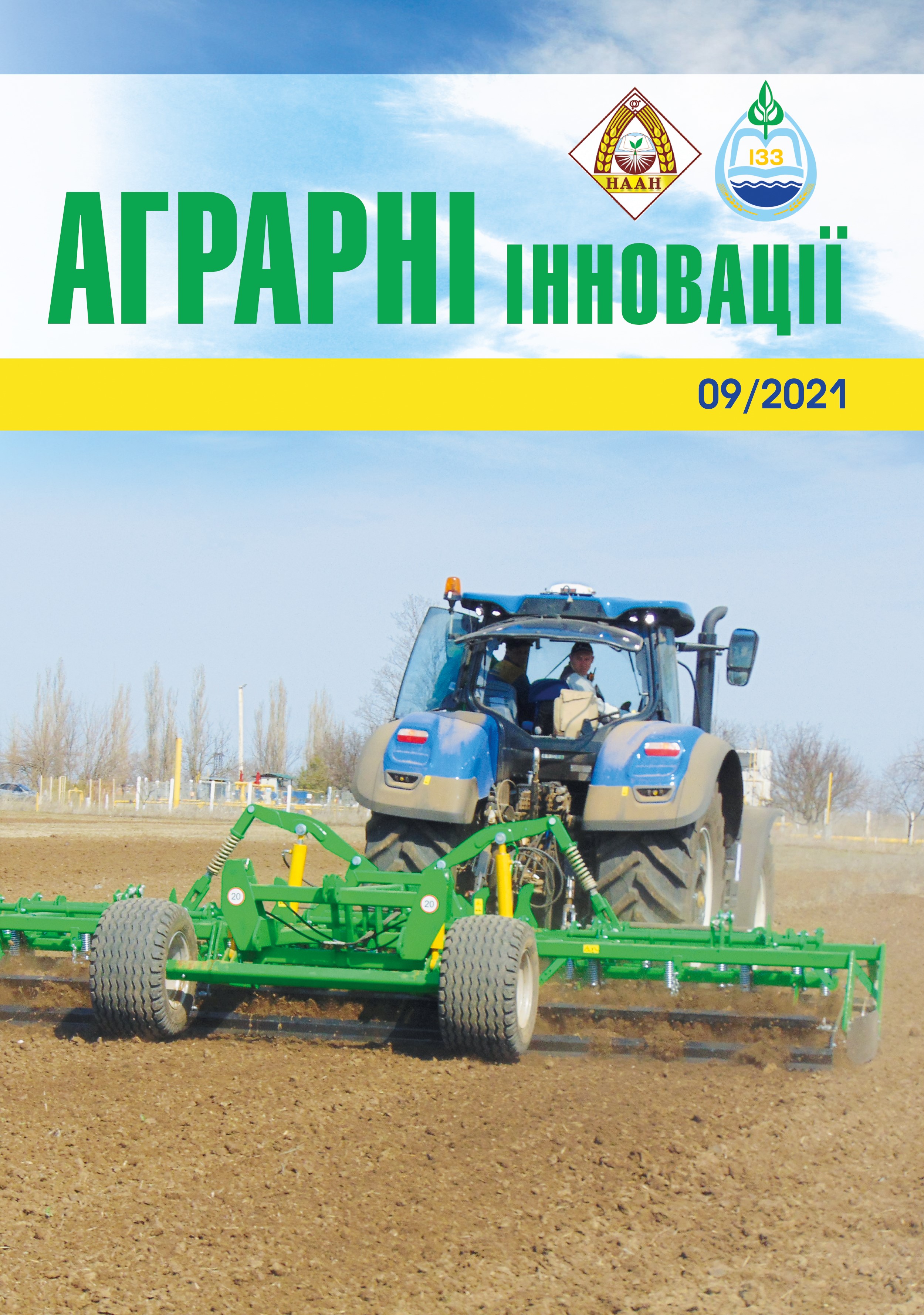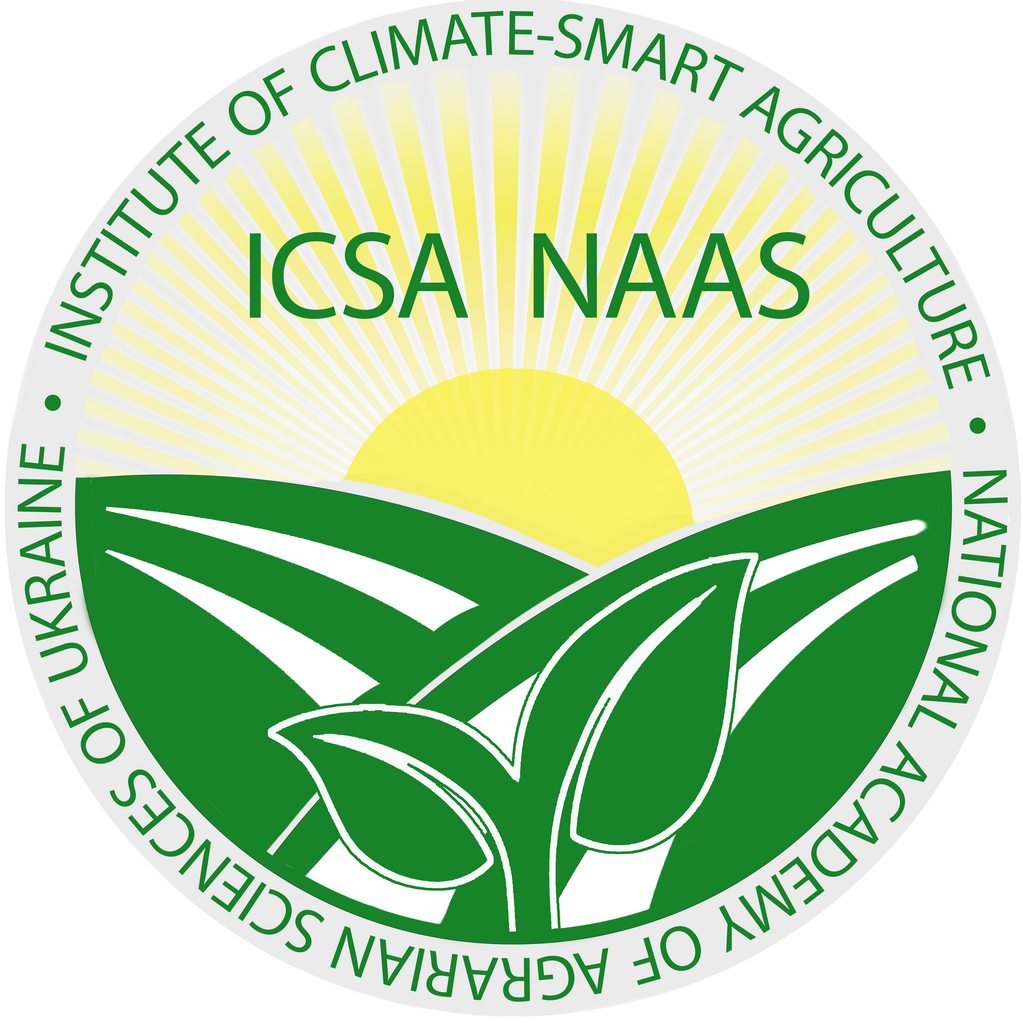Features of inheritance of grain mass from the main ear and hybridization of different precocious varieties of soft winter wheat
Abstract
The aim of the research – establishing the features of inheritance of grain mass from the main ear in firstgeneration hybrids, collected from hybridization of different precocious varieties of soft winter wheat. Methods. In the experimental field of the research and production center of Bila Tserkva NAU in 2018 – 2020, 45 combinations that were obtained from crossing earlymaturing varieties were studied: Myr. early, Kolchuga, B. TS. n/k.; middle-early: Zolot., Chornyava, Shched. n.; mediumripe: Stol., Vidrada, Myr. 61, Anton., Yednist; middle-late: Dobirna, Pyvna and Vdala. Seeds F1 and parental forms were sown according to the scheme ♀–F1–♂. Biometric analysis of the test material was performed on an average sample of 25 plants in triplicate. Statistical processing of the obtained biometric data was carried out according to the method of B.A. Dospekhov (1985). Hypothetical and true heterosis by grain weight from the main ear in F1 was determined by за Matzinger D. F. (1962), S. Fonseca, F. Patterson (1968). The degree of phenotypic dominance was determined by B. Griffing (1950), and the obtained data were classified by G. M. Beil, R. E. Atkins (1965). Results. During three years positive hypothetical heterosis defined in 27, and true in 18 from 45 crossbreeding combinations. Consistently high hypothetical and true heterosis were characterized: Vdala / Pyvna; Yednist / Vidrada; Zolot. / Vidrada; Zolot. / Stol.; Vdala / Stol.; Zolot. / Shched. n.; B.TS. n/k. / Vidrada. Exept Zolot. / Shched. n. and B.TS. n/k./ Vidrada, all other hybrids exceeded the average of research indicator of grain weight from the main ear. Conclusions. The research found that the mass of grain from the main ear of soft winter wheats is a genetically determined trait that is affected by year conditions and is realized by the interaction of "genotype-conditions of the year". The significant influence of parental components of hybridization and conditions of the year on the formation of grain mass of the main ear, indicators of heterosis and the degree of phenotypic dominance in first-generation hybrids was revealed. The most common type of inheritance of grain weight from the main ear in F1 soft winter wheat has a positive over-dominance, which is determined in 82.5% of hybrids. Selected combinations: Vdala / Pyvna, Zolot. / Stol., Kolchuga / Stol., Vdala / Stol., Zolot. / Vidrada, Yednist / Vidrada, Anton. / Stol., Myr. early / Yednist with positive overdominance in which on average in 2018-2020 formed a high productivity of the ear – 2.66-3.11 g.
References
2. El-Hosary A. A., El-Badawy M., Mehasen S. A. S., El-Akkad T. A., El-Fahdawy A. Genetic diversity among wheat genotypes using RAPD markers and its implication on genetic variability of diallel crosses. Bio. Sci. Res. 2019. Vol. 16, No 2. P. 1258–1266.
3. Curtis T., Halford N. G. Food security: the challenge of increasing wheat yield and the importance of not compromising food safety. Annals of applied biology. 2014. Vol. 164, No 3. P. 354–372.
4. Tahir S., Ahmad A., Khaliq T., Cheema M. J. Evaluating the impact of seed rate and sowing dates on wheat productivity in semi-arid environment. Int. J. Agric. Biol. 2019. Vol. 22. P. 57–64.
5. Li J., Jiao G., Sun Y., Chen J., Zhong Y., Yan L., Xia L. Modification of starch composition, structure and properties through editing of TaSBEIIa in both winter and spring wheat varieties by CRISPR/Cas9. Plant Biotechnology Journal. 2021. Vol. 19, No 5. P. 937–951.
6. Gbegbelegbe S., Cammarano D., Asseng S., Robertson R., Chung U., Adam M., Shiferaw B. Baseline simulation for global wheat production with CIMMYT mega-environment specific cultivars. Field Crops Res. 2017. Vol. 202. 122–135.
7. Hongjie L, Timothy D. M., Intoshc R. A., Yang Z. Breeding new cultivars for sustainable wheat production. The Crop Journal. 2019. Vol. 7, No 6. P. 715–717.
8. Ahmad M. J., Iqbal M. A., Choi K. S. Climatedriven constraints in sustaining future wheat yield and water productivity. Agric. Water Manag. 2020. Vol. 231. P. 105991.
9. Giraldo P., Benavente E., Manzano-Agugliaro F., Gimenez E. Worldwide research trends on wheat and barley: A bibliometric comparative analysis. Agronomy. 2019. Vol. 9. P. 352.
10. Volkova L. V. Productivity of spring wheat and its relation to elements of yield structure in years differ by meteorological conditions. Agricultural Science Euro-North-East. 2016. Vol. 6. P. 9–15.
11. Kozlov V. E. Agricultural and breeding prerequisites for successful introduction of Mironovka winter wheat varieties in the USSR as the base for introducing new varieties resistant to Siberian winter. Vavilov Journal of Genetics and Breeding. 2015. Vol. 17, No 3. P. 541–557.
12. Nekrasova О., Kravchenko N., Marchenko D., Nekrasov E. Estimation of grain productivity and biochemical indicators of the winter bread wheat varieties depending on the forecrop. In E3S Web of Conferences. 2021. Vol. 273. P. 01027.
13. Базалій В. В. Бойчук І. В. Трансгресивна мінливість гібридів пшениці м’якої озимої і її використання в селекції. Таврійський науковий вісник. 2012. № 78. С. 3–8.
14. Лозінська Т. Успадкування та трансгресивна мінливість маси зерна колоса у F1 і F2 пшениці ярої. ΛΌГOΣ. мистецтво наукової думки. 2019. № 4. С. 129-131.
15. Бурденюк-Тарасевич Л. А., Лозінський М. В. Зернова продуктивність ліній пшениці м’якої озимої, отриманих від схрещування батьківських форм різного еколого-географічного походження. Агробіологія: збірник наукових праць. 2014. № 1 (109). С. 11-16.
16. Бурденюк-Тарасевич Л. А., Лозінський М. В. Формування довжини головного колоса в ліній пшениці озимої різного еколого-географічного походження. Агробіологія: збірник наукових праць. 2013. № 11 (104). С. 30-34.
17. Дубовик Н. С., Гуменюк О. В., Кириленко В. В. Довжина головного колоса у гібридів F1 Triticum аestivum L., створених за участі носіїв пшенично-житніх транслокацій. Миронівський вісник. 2017. №. 5. С. 56-69.
18. Панкова О. В., Пузік В. К., Лисиченко М. Л. Вплив електромагнітного випромінювання на рослини: монографія. Харків: ТОВ «Планета-Прінт», 2021. 159 с.
19. Хоменко С. О., Солона В. Й., Зварун Т. В. Особливості селекції пшениці ярої в умовах Лісостепу України. Селекція і насінництво. 2011. № 100. С. 181-191.
20. Prasad K. D., Haque M. F., Ganguli D. K. Heterosis studies for yield and its components in bread wheat (Triticum aestivum L.). Indian J. Genet. 1998. No 1. P. 97–100.
21. Горбачова С. М. Результати і методи селекції зі створення нових конкурентоспроможних сортів проса. Селекція і насінництво. 2011. No 99. С. 108–114.
22. Орлюк А. П. Генетика пшениці з оновами селекції: монографія. Херсон: Айлант, 2012. 436 с.
23. Ларченко К. А., Моргун Б. В. Ознаки якості зерна пшениці та методи їх поліпшення. Физиология и биохимия культурных растений. 2010. Т. 42, № 6. С. 463–474.
24. Васильківський С. П., Івко Ю. О. Ефект гетерозису та ступінь фенотипового домінування у гібридів F1 ріпаку озимого. Агробіологія: збірник наукових праць. 2013. Вип. 10.(100). С. 5–10.
25. Лихочвор В. В. Продуктивность и структура урожая озимой пшеницы. Зерно. 2008. № 7. С. 24–28.
26. Лозінська Т. П. Формування елементів продуктивності нових сортів пшениці м’якої ярої в умовах Лісостепу України. Агробіологія: збірник наукових праць. 2013. Вип. 10 (100). С. 22–25.
27. Волкодав В. В. Методика державного випробування сортів рослин на придатність до поширення в Україні: заг. част. Охорона прав на сорти рослин: Офіційний бюлетень. Київ: Алефа. 2003. Вип.1. ч. 3. 106 с.
28. Доспехов Б. А. Методика полевого опыта. Москва: Агропромиздат. 1985. 352 с.
29. Matzinger D. F., Mannand T. J., Cockerham C. C. Diallel cross in Nicotiana tabacum. Crop Science. 1962. No 2. P. 238–286.
30. Fonseca S., Patterson F. L. Hybrid vigor in a seven parent diallel cross in common winter wheat (Triticum aestivum L.). Crop Science. 1968. No 1. P. 85–88.
31. Griffing B. Analysis of quantitative gene-action by constant parent regression and related techniques. Genetics. 1950. No 35. P. 303–321.
32. Beil G. M., Atkins R. E. Inheritance of quantitative characters in grain sorghum. Iowa State Journal. 1965. No 39. P. 3.
33. Рипбергер Е.И., Боме Н. А. Изучение комбинационной способности мягкой яровой пшеницы ((Triticum aestivum L.) в системе диалельных скрещиваний. Sworld. 2014.






